Bad Gastein
Bad Gastein (German pronunciation: [baːt ɡasˈtaɪn] formerly Badgastein[3] Southern Bavarian: Bod Goschdei) is a spa town in the district of St. Johann im Pongau, in the Austrian state of Salzburg. Picturesquely situated in a high valley of the Hohe Tauern mountain range, it is known for the Gastein Waterfall and a variety of Belle Époque hotel buildings.
Bad Gastein | |
|---|---|
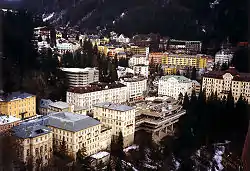 Town centre | |
 Coat of arms | |
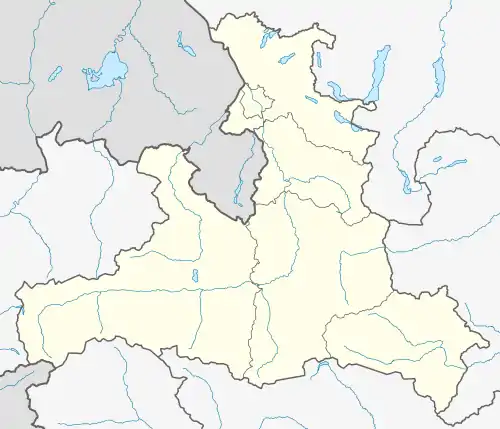 Bad Gastein Location within Salzburg State  Bad Gastein Location within Austria | |
| Coordinates: 47°6′0″N 13°1′0″E | |
| Country | |
| State | Salzburg |
| District | St. Johann im Pongau |
| Government | |
| • Mayor | Thomas Lauterbach (No Party) |
| Area | |
| • Total | 170.6 km2 (65.9 sq mi) |
| Elevation | 1,002 m (3,287 ft) |
| Population (2018-01-01)[2] | |
| • Total | 3,980 |
| • Density | 23/km2 (60/sq mi) |
| Time zone | UTC+1 (CET) |
| • Summer (DST) | UTC+2 (CEST) |
| Postal code | 5640 |
| Area code | 06434 |
| Vehicle registration | JO |
| Website | http://www.bad-gastein.at |
Geography
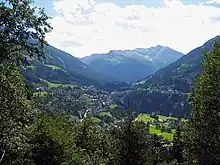
Bad Gastein is located in the historic Pongau region, the municipal area of about 171 square kilometres (66 sq mi) is the largest in St. Johann im Pongau District. It stretches along the upper Gastein Valley following the course of the Gastein Ache creek, a right tributary of the Salzach river. The valley separates the Hohe Tauern Ankogel Group in the east from the Goldberg Group in the west.
The town centre is located at the Gastein Falls, about 1,000 metres (3,300 ft) above sea level. It is characterised by numerous historic multi-storey hotel buildings erected on the steep slopes.
The Gastein municipality comprises the cadastral communities of Badgastein, Böckstein, and Remsach.
Transportation
The Gastein valley is accessible by the Tauern Railway, a major railroad running from Schwarzach-Sankt Veit in the north across the Alpine crest through the Tauern Tunnel to Spittal an der Drau, Carinthia in the south. Frequent EuroCity and InterCity trains going along this route connect Bad Gastein with many Austrian cities like Vienna, Linz, Salzburg and Graz along a single circuit.
The B167 Gasteiner Straße highway also passes right through the Gastein valley. Through traffic from the northern branch-off at Lend in the Salzach valley passes the lower municipalities of Dorfgastein and Bad Hofgastein before reaching the Bad Gastein centre. However, in Böckstein at the head of the valley, the continuation southwards to Mallnitz in Carinthia requires cars to roll onto a shuttle train (Autoverladung) for a short trip through the Tauern Tunnel.
Spa and therapy
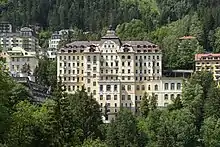
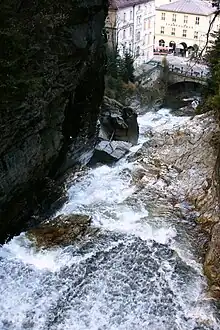
The German word "Bad" means "spa", reflecting the town's history as a health resort. The local Heilstollen (literally 'healing tunnel') thermal spring water earned the town its early fame. Theophrastus Parcelsus (1493–1541) had studied the spring water to discover its secrets. Marie Curie (1867–1934) and Heinrich Mache (1876–1954) helped to discover that it contained radon and as a result radon therapy began in the town. Radon inhalation therapy at the Gasteiner Heilstollen began as a result of further investigation into the experiences of humans who worked in silver mining who noticed improvements in symptoms from various ailments. Like any Austrian spa town in the early 19th century, Bad Gastein did not only attract desperate patients.[4]
The Grandhotel Gasteinerhof has residential outbuildings and modern urban design integrates the historic ensemble, which includes a spa with a glass corridor over a creek with pristine alpine water.[5]
The Austrian spa of Bad Gastein has special trains for spa guests, who are driven deep into the cave of the Böckstein mountain. There guests can lie for several hours to breathe in radon gas. To accommodate spa guests, the tunnels originally dug for gold mining have been converted.[6]
History
The remote valley was settled by Bavarian peasants in the 9th century; field names in the highest-lying southern parts also denote a Carantanian (Slavic) colonization. Gastein is first mentioned as Gastuna in a 963 deed, when the area belonged to the German stem duchy of Bavaria. It was originally an alpine farming and gold mining area and the site of an ancient trade route crossing the main ridge of the Central Eastern Alps. In 1297 Otto III, Duke of Bavaria and his brother Stephen I, Duke of Bavaria, both highly indebted, sold it to the Archbishopric of Salzburg. Already about 1230, the minnesinger Neidhart von Reuental had referred to the hot springs in his Middle High German poem Die Graserin in der Gastein. The spas in Bad Gastein were visited by the House of Habsburg emperor Frederick III, Holy Roman Emperor. The Renaissance physician Paracelsus also visted Bad Gastein.
High society
In the 19th century the waters of Bad Gastein became fashionable. Notable guests of the past included Empress Elisabeth of Austria, as well as Wilhelm I, German Emperor with his chancellor Otto von Bismarck.[7] Ferdinand I of Bulgaria, Faisal I of Iraq, Ibn Saud of Saudi Arabia, and Mohammad Reza Pahlavi also count among the notable guests. Industrialists like Wilhelm von Opel resided in Bad Gastein on occasion.
Artists like Heinrich Mann, Robert Stolz, and W. Somerset Maugham paid a visit too. The composer Franz Schubert composed his Piano Sonata in D Major in Bad Gastein, and was once believed to have sketched a Gmunden-Gastein Symphony (D. 849) during his stay in August and September 1825. Though no score appears to have survived for the latter, it is often identified with the Symphony No. 9 in C major (D. 944).
Mass tourism
At the end of the 19th century skiing was developed as tourism activity in the alps. Resorts such as Davos and St. Moritz catered to the wealthy health tourist, while popular mass tourism could only be sustained with the expansion of the railroads. Bad Gastein, Saint-Gervais-les-Bains, and Bad Ischl were established as health spas.[8]
In the 1960s Bad Gastein was frequented by Jewish emigrants from Nazi Germany and German-occupied Europe. Those who could afford to visit their old home (alte Heimat) met in Bad Gastein. Returning from their travels they shared their experiences with other refugees in newsletters and presentations.[9]
From the 1960s on the Bad Gastein lost some of its former reputation and many older hotels sat empty. Recently, Bad Gastein renovated its Felsentherme in 2014.[10]
Places of interest
.JPG.webp)
- Gletschermühlen
- Felsentherme
- Gasteiner Heilstollen
- Gasteiner Museum
Climate
Bad Gastein has a humid continental climate (Dfb) bordering on a subarctic climate (Dfc) due to the town's high elevation. Summers are mild, sometimes warm with cool, refreshing nights. Winters are moderately cold and snowy, with annual snowfall averaging 136 inches (345 cm).
| Climate data for Bad Gastein (1981–2010) | |||||||||||||
|---|---|---|---|---|---|---|---|---|---|---|---|---|---|
| Month | Jan | Feb | Mar | Apr | May | Jun | Jul | Aug | Sep | Oct | Nov | Dec | Year |
| Record high °C (°F) | 14.0 (57.2) |
16.4 (61.5) |
20.0 (68.0) |
23.2 (73.8) |
28.6 (83.5) |
31.4 (88.5) |
32.3 (90.1) |
31.3 (88.3) |
28.0 (82.4) |
25.8 (78.4) |
22.6 (72.7) |
16.0 (60.8) |
32.3 (90.1) |
| Average high °C (°F) | 0.8 (33.4) |
3.1 (37.6) |
7.0 (44.6) |
11.3 (52.3) |
16.7 (62.1) |
19.3 (66.7) |
21.6 (70.9) |
20.9 (69.6) |
17.1 (62.8) |
13.0 (55.4) |
5.7 (42.3) |
1.2 (34.2) |
11.5 (52.7) |
| Daily mean °C (°F) | −3.8 (25.2) |
−2.4 (27.7) |
1.3 (34.3) |
5.3 (41.5) |
10.2 (50.4) |
13.0 (55.4) |
14.9 (58.8) |
14.3 (57.7) |
10.7 (51.3) |
6.7 (44.1) |
1.1 (34.0) |
−2.7 (27.1) |
5.7 (42.3) |
| Average low °C (°F) | −7.2 (19.0) |
−6.3 (20.7) |
−2.8 (27.0) |
0.9 (33.6) |
5.2 (41.4) |
8.0 (46.4) |
10.0 (50.0) |
9.7 (49.5) |
6.4 (43.5) |
2.7 (36.9) |
−2.0 (28.4) |
−5.8 (21.6) |
1.6 (34.9) |
| Record low °C (°F) | −23.5 (−10.3) |
−21.0 (−5.8) |
−21.5 (−6.7) |
−12.2 (10.0) |
−5.2 (22.6) |
0.4 (32.7) |
−0.3 (31.5) |
1.4 (34.5) |
−3.4 (25.9) |
−11.6 (11.1) |
−16.5 (2.3) |
−21.0 (−5.8) |
−23.5 (−10.3) |
| Average precipitation mm (inches) | 51 (2.0) |
46 (1.8) |
69 (2.7) |
76 (3.0) |
110 (4.3) |
154 (6.1) |
174 (6.9) |
154 (6.1) |
116 (4.6) |
97 (3.8) |
86 (3.4) |
62 (2.4) |
1,196 (47.1) |
| Average snowfall cm (inches) | 58 (23) |
60 (24) |
62 (24) |
33 (13) |
4 (1.6) |
0 (0) |
0 (0) |
0 (0) |
1 (0.4) |
15 (5.9) |
42 (17) |
70 (28) |
345 (136) |
| Average relative humidity (%) (at 14:00) | 70.7 | 57.5 | 52.2 | 47.2 | 46.6 | 50.9 | 51.8 | 53.6 | 54.2 | 55.7 | 68.8 | 77.0 | 57.2 |
| Mean monthly sunshine hours | 52 | 89 | 110 | 123 | 159 | 153 | 176 | 155 | 126 | 114 | 58 | 30 | 1,344 |
| Source: Central Institute for Meteorology and Geodynamics[11][12][13][14][15] | |||||||||||||
| Climate data for Bad Gastein (1971–2000) | |||||||||||||
|---|---|---|---|---|---|---|---|---|---|---|---|---|---|
| Month | Jan | Feb | Mar | Apr | May | Jun | Jul | Aug | Sep | Oct | Nov | Dec | Year |
| Record high °C (°F) | 14.5 (58.1) |
16.4 (61.5) |
20.0 (68.0) |
23.2 (73.8) |
28.5 (83.3) |
29.4 (84.9) |
32.3 (90.1) |
31.4 (88.5) |
28.2 (82.8) |
25.8 (78.4) |
19.5 (67.1) |
16.0 (60.8) |
32.3 (90.1) |
| Average high °C (°F) | 1.4 (34.5) |
3.1 (37.6) |
7.0 (44.6) |
10.4 (50.7) |
16.0 (60.8) |
18.5 (65.3) |
20.7 (69.3) |
20.6 (69.1) |
17.1 (62.8) |
12.4 (54.3) |
5.3 (41.5) |
1.6 (34.9) |
11.2 (52.2) |
| Daily mean °C (°F) | −3.2 (26.2) |
−2.1 (28.2) |
1.5 (34.7) |
4.7 (40.5) |
9.8 (49.6) |
12.4 (54.3) |
14.4 (57.9) |
14.1 (57.4) |
10.6 (51.1) |
6.4 (43.5) |
0.7 (33.3) |
−2.5 (27.5) |
5.6 (42.1) |
| Average low °C (°F) | −6.5 (20.3) |
−5.9 (21.4) |
−2.5 (27.5) |
0.5 (32.9) |
4.9 (40.8) |
7.6 (45.7) |
9.5 (49.1) |
9.5 (49.1) |
6.3 (43.3) |
2.5 (36.5) |
−2.4 (27.7) |
−5.5 (22.1) |
1.5 (34.7) |
| Record low °C (°F) | −23.5 (−10.3) |
−21 (−6) |
−19.5 (−3.1) |
−10.7 (12.7) |
−11 (12) |
−3.3 (26.1) |
−0.3 (31.5) |
1.5 (34.7) |
−2 (28) |
−11.6 (11.1) |
−16.5 (2.3) |
−19.8 (−3.6) |
−23.5 (−10.3) |
| Average precipitation mm (inches) | 49.7 (1.96) |
44.6 (1.76) |
67.4 (2.65) |
80.6 (3.17) |
103.4 (4.07) |
153.7 (6.05) |
163.5 (6.44) |
147.1 (5.79) |
112.0 (4.41) |
90.5 (3.56) |
81.5 (3.21) |
60.2 (2.37) |
1,154.2 (45.44) |
| Average snowfall cm (inches) | 41.5 (16.3) |
44.0 (17.3) |
48.6 (19.1) |
24.1 (9.5) |
4.9 (1.9) |
0.0 (0.0) |
0.0 (0.0) |
0.0 (0.0) |
0.6 (0.2) |
10.9 (4.3) |
29.5 (11.6) |
53.0 (20.9) |
257.1 (101.2) |
| Average precipitation days (≥ 1.0 mm) | 7.7 | 8.4 | 10.9 | 11.6 | 13.5 | 16.1 | 16.3 | 14.6 | 11.2 | 9.5 | 9.7 | 9.4 | 138.9 |
| Average relative humidity (%) (at 14:00) | 67.6 | 56.9 | 50.7 | 47.4 | 46.1 | 50.4 | 51.3 | 52.3 | 52.9 | 55.0 | 67.0 | 73.6 | 55.9 |
| Mean monthly sunshine hours | 56.4 | 83.0 | 108.6 | 112.3 | 157.7 | 142.0 | 166.0 | 157.2 | 128.4 | 109.1 | 58.9 | 37.5 | 1,317.1 |
| Percent possible sunshine | 44.6 | 47.2 | 46.8 | 40.6 | 46.5 | 39.1 | 48.8 | 52.8 | 52.8 | 52.1 | 40.5 | 43.1 | 46.2 |
| Source: Central Institute for Meteorology and Geodynamics[16] | |||||||||||||
Sports

Bad Gastein is popular for winter sports. Bad Gastein hosted the 1958 World Championships in alpine skiing and regularly is a scene of the snowboarding and boardercross world cup. The Bad Gastein and Bad Hofgastein ski resort is part of the larger Ski Amadé network, with Gastein valley having 4 ski areas with over 200 kilometers of downhill slopes.[17] Many establishments on the slopes offer warmth, food and strong drinks.
Since 2007, the town also annually hosts the Gastein Ladies tennis tournament, an International event on the WTA Tour, attracting top players like Julia Görges.
Notable people
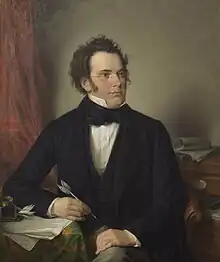
- Thea Hochleitner (1925–2012), alpine skier
- Hans Eder (1927–2008), Nordic skier
- Franz Xaver Franzmair (1901–1988) hotelier and builder, Freeman of Bad Gastein
- Hermann Greinwald (1927–1990) doctor and mountain rescue doctor
- Fritz Gruber (born 1940) local historian of Gastein alley and botanist
- Franz Schubert (1797–1828) composed after a holiday in Bad Gastein the "Gasteiner Piano Sonata in D major"
- Karl Straubinger (1855–1924) mayor (1882–1917), freeman of Bad Gasteins
- Georg Thomalla (1915–1999) German actor
- Erwin Wexberg (1889–1957) individual psychologian, doctor, student of Alfred Adler
- Eckart Witzigmann (born 1941) Austrian master cook, freeman of Bad Gastein
- Maria Zittrauer (1913–1997) lyrician, Trakl-Prize-winner 1952
- Fedor Ivanovich Shalyapin, singer, Feodor Chaliapin
References
- "Dauersiedlungsraum der Gemeinden Politischen Bezirke und Bundesländer - Gebietsstand 1.1.2018". Statistics Austria. Retrieved 10 March 2019.
- "Einwohnerzahl 1.1.2018 nach Gemeinden mit Status, Gebietsstand 1.1.2018". Statistics Austria. Retrieved 9 March 2019.
- New Mexican (Newspaper), Santa Fe, NM, January 8, 1988, p. 8, The Daily Register (Newspaper) Shrewsbury, New Jersey, February 3, 1976, p. 12, The Daily Colonist (Newspaper), Victoria, BC, August 29, 1909
- Ian Bradley (2020). Health, Hedonism and Hypochondria: The Hidden History of Spas. Bloomsbury Publishing. p. 34. ISBN 9780755626670.
- Thies Schröder (2014). City by Landscape: The Landscape Architecture of Rainer Schmidt. Birkhäuser. p. 19-21. ISBN 9783034610834.
- Ian Bradley (2020). Health, Hedonism and Hypochondria: The Hidden History of Spas. Bloomsbury Publishing. p. 7. ISBN 9780755626670.
- Bose, Sugata (2011), His Majesty's Opponent: Subhas Chandra Bose and India's Struggle against Empire, Harvard University Press, p. 127, ISBN 978-0-674-04754-9, retrieved 22 September 2013
- Andrew Holden (2007). Environment and Tourism. Taylor & Francis. p. 34-35. ISBN 9781134148790.
- Anne C. Schenderlein (2019). Germany On Their Minds: German Jewish Refugees in the United States and Their Relationships with Germany, 1938-1988. Berghahn Books. p. 168. ISBN 9781789200119.
- "Felsentherme Bad Gastein". Thermenhotels Gastein. Retrieved 28 September 2022.
- "Klimamittel 1981–2010: Lufttemperatur" (in German). Central Institute for Meteorology and Geodynamics. Archived from the original on 21 October 2019. Retrieved 24 November 2019.
- "Klimamittel 1981–2010: Niederschlag" (in German). Central Institute for Meteorology and Geodynamics. Archived from the original on 29 December 2014. Retrieved 24 November 2019.
- "Klimamittel 1981–2010: Schnee" (in German). Central Institute for Meteorology and Geodynamics. Archived from the original on 29 December 2014. Retrieved 24 November 2019.
- "Klimamittel 1981–2010: Luftfeuchtigkeit" (in German). Central Institute for Meteorology and Geodynamics. Archived from the original on 21 October 2019. Retrieved 24 November 2019.
- "Klimamittel 1981–2010: Strahlung" (in German). Central Institute for Meteorology and Geodynamics. Archived from the original on 29 December 2014. Retrieved 24 November 2019.
- "Klimadaten von Österreich 1971–2000 – Salzburg-Badgastein" (in German). Central Institute for Meteorology and Geodynamics. Archived from the original on 12 October 2019. Retrieved 24 November 2019.
- "Gastein". Ski Amadé. Retrieved 28 September 2022.
